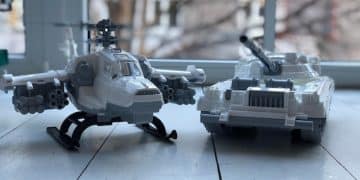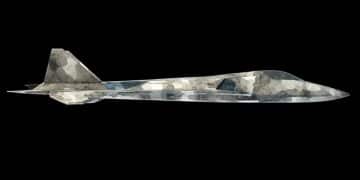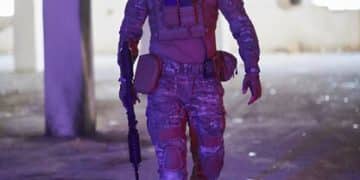US Army’s New Robotic Combat Vehicles: Key Features Revealed
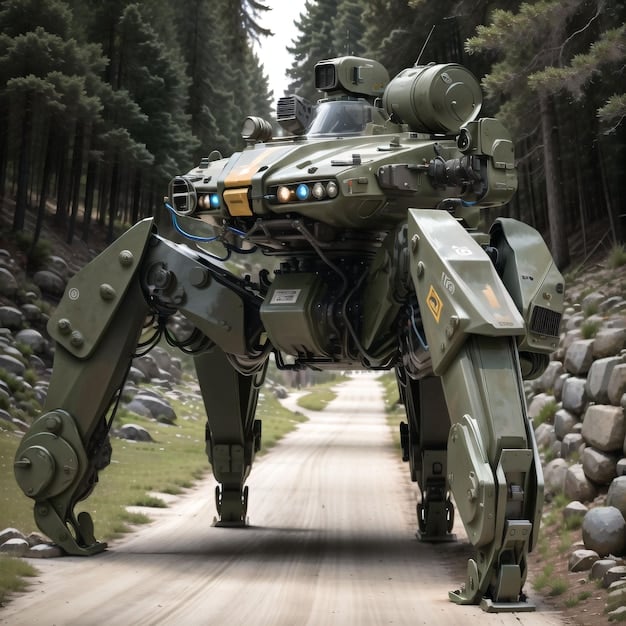
The U.S. Army’s new Robotic Combat Vehicles (RCVs) are designed to augment existing manned platforms, offering enhanced situational awareness, increased lethality, and reduced risk to human personnel through modularity, advanced autonomy, and integrated sensor suites.
The landscape of modern warfare is undergoing a profound transformation, driven by advancements in artificial intelligence and automation. At the forefront of this evolution is the US Army’s strategic initiative to integrate Robotic Combat Vehicles (RCVs) into its combat formations. These unmanned ground vehicles are poised to redefine battlefield tactics, offering unparalleled capabilities while mitigating risks to human soldiers.
The strategic imperative for Robotic Combat Vehicles
The concept of robotic warfare is not new, but the US Army’s pursuit of Robotic Combat Vehicles represents a significant leap forward in operationalizing unmanned systems for direct combat roles. This move is driven by a complex interplay of strategic imperatives, including the need to maintain overmatch against potential adversaries, reduce casualties in high-threat environments, and adapt to the increasingly complex and dispersed nature of modern battlefields. The Army recognizes that relying solely on traditional manned platforms may not be sufficient to address future asymmetric threats or to operate effectively in denied and contested spaces.
One of the primary drivers is enhancing the survivability of combat forces. By deploying RCVs into the most dangerous situations, the Army can project power and gather critical intelligence without directly exposing human soldiers to enemy fire. This strategic shift not only protects personnel but also allows for more aggressive reconnaissance, target acquisition, and even direct engagement. The ability of RCVs to operate autonomously or semi-autonomously also streamlines decision-making processes in dynamic environments, potentially speeding up reaction times and improving overall tactical responsiveness. Moreover, RCVs are seen as a force multiplier, capable of augmenting existing manned units by performing tasks that are too risky, dull, or dirty for human soldiers.
Addressing the asymmetric threat
The rise of sophisticated near-peer adversaries and the prevalence of irregular warfare necessitate a different approach to combat operations. RCVs offer a flexible and scalable solution to these evolving challenges.
- Enhanced Persistence: RCVs can remain in high-threat areas for extended periods without fatigue, providing continuous surveillance or deterrent capabilities.
- Reduced Logistical Burden: While requiring maintenance, RCVs eliminate the need for life support systems, significantly reducing the logistical footprint associated with human presence in dangerous zones.
- Swarming Capabilities: The potential to deploy multiple RCVs in coordinated swarms could overwhelm enemy defenses and provide multi-faceted attack vectors.
This technological pivot is not merely about adding new equipment; it represents a fundamental re-evaluation of military doctrine and training. Integrating RCVs will require new skill sets for soldiers, new command and control structures, and a new understanding of human-machine teaming. The Army’s goal is to create a symbiotic relationship where RCVs enhance human capabilities rather than replacing them entirely, allowing soldiers to focus on higher-level analytical and decision-making tasks while the robots handle the more perilous and repetitive actions. The strategic imperative is clear: to build a more resilient, adaptive, and lethal fighting force for the challenges of the 21st century.
Modularity and adaptability: The core of RCV design
The design philosophy behind the US Army’s new Robotic Combat Vehicles centers heavily on modularity and adaptability, recognizing that the battlefield of tomorrow will demand extreme flexibility. These vehicles are envisioned not as single-purpose machines, but as versatile platforms capable of rapidly reconfiguring to meet diverse mission requirements. This approach stands in stark contrast to traditional military vehicle development, where platforms are often designed for very specific roles, limiting their utility as threats evolve. The Army understands that future conflicts will be characterized by unpredictability, requiring assets that can quickly pivot from reconnaissance to direct action, or from logistics support to electronic warfare, often within the same mission.
Modularity in RCVs means that various payloads, weapon systems, and sensor packages can be easily swapped in and out, much like components on a customizable desktop computer. This allows commanders to tailor the vehicle’s capabilities to the specific nuances of a given operation, whether it’s an urban combat scenario requiring advanced close-quarters sensing or an open-field engagement necessitating long-range anti-armor capabilities. This interchangeable design principle significantly reduces the time and cost associated with acquiring new vehicles for every specialized task, instead leveraging a common base platform. Furthermore, it fosters innovation, as new technologies and capabilities can be integrated into the existing RCV fleet as they become available, without requiring a complete overhaul of the vehicles themselves.
Payload flexibility and mission sets
The ability to quickly change out mission packages is paramount for RCVs. This flexibility extends beyond just weapon systems.
- Reconnaissance and Surveillance: Easily integrate high-definition cameras, thermal imagers, and ground-penetrating radar.
- Direct Fire Support: Mount machine guns, automatic cannons, and even anti-tank guided missiles (ATGMs).
- Logistics and Resupply: Transform into cargo carriers for ammunition, medical supplies, or water, reducing soldier burden.
Beyond tangible payloads, adaptability also encompasses software and autonomous capabilities. The RCVs are being developed with open architecture computing systems, allowing for rapid software updates and the integration of new AI algorithms. This ensures that the vehicles can continuously adapt to new Tactics, Techniques, and Procedures (TTPs) and counter emerging threats. The goal is to create a dynamic platform that improves over time through software enhancements, rather than becoming obsolete. This forward-thinking design ensures that the RCVs will remain relevant and effective assets for decades to come, providing a significant return on investment for the military.
Advanced autonomy and teaming capabilities
The true game-changer for the US Army’s new Robotic Combat Vehicles lies in their advanced autonomy and their capacity for seamless human-machine teaming. These are not merely remote-controlled drones; they are intelligent platforms designed to operate with varying degrees of independence, significantly extending the reach and effectiveness of human soldiers. The spectrum of autonomy envisioned for RCVs ranges from supervised autonomy, where a human operator provides high-level commands, to fully autonomous operations in highly structured or predictable environments. This tiered approach allows the Army to gradually integrate RCVs into operations, building trust and refining capabilities as the technology matures. The promise of advanced autonomy is the ability to free human soldiers from repetitive, dangerous, or physically demanding tasks, allowing them to focus on complex decision-making, strategic planning, and adapting to unforeseen circumstances.
Central to this feature is the concept of “teaming,” wherein RCVs work in concert with manned vehicles and dismounted soldiers, rather than operating in isolation. This involves sophisticated communication protocols and artificial intelligence algorithms that enable RCVS to understand human intent, anticipate actions, and coordinate complex maneuvers. Imagine a manned tank leading a column, with RCVs flanking it, providing forward reconnaissance, drawing enemy fire, or even relaying targeting information. This synergistic relationship enhances situational awareness for the entire unit, dramatically increases reaction times, and allows for more complex tactical formations. The RCVs become an extension of the human fighting force, augmenting their senses, strength, and endurance.
Key aspects of autonomous operation
The development of RCV autonomy is focused on several critical areas to ensure effective and safe integration into combat scenarios.
- Situational Understanding: Advanced sensor fusion, combining lidar, radar, and cameras, enables RCVs to build detailed 3D maps of their surroundings and identify threats.
- Path Planning and Navigation: Algorithms allow RCVs to autonomously plot optimal routes, avoid obstacles, and navigate complex terrain without constant human input.
- Decision-Making under Uncertainty: AI models are being trained to assess threats, prioritize targets (under human supervision for lethal engagement), and react to dynamic battlefield conditions.
The challenges of developing truly advanced autonomy are substantial, encompassing not only the technological hurdles of perception and decision-making but also ethical considerations regarding lethal autonomy. The Army is committed to ensuring that a human remains “in the loop” for any lethal engagements, maintaining accountability and upholding moral standards. However, the ability of RCVs to perform non-lethal autonomous tasks, such as reconnaissance, logistics, and target designation, will still revolutionize battlefield operations. This careful balance between autonomy and human control is critical for building trust in these systems and ensuring their responsible deployment in future conflicts.

Enhanced situational awareness and intelligence gathering
One of the most immediate and impactful benefits of the US Army’s new Robotic Combat Vehicles is their capacity to provide unparalleled situational awareness and intelligence gathering capabilities. Unlike manned vehicles, which are limited by human physiology and vulnerability, RCVs can be equipped with a comprehensive suite of advanced sensors, allowing them to operate in environments too dangerous or inaccessible for human observation. This includes persistent surveillance in contested areas, discreet reconnaissance behind enemy lines, and the ability to detect threats far sooner and more accurately than traditional methods. The data collected by these unmanned platforms will revolutionize how commanders understand the battlefield, enabling more informed decision-making and pre-emptive action.
The integrated sensor packages on RCVs are designed to fuse multiple data streams into a coherent operational picture. This means combining visual light cameras with thermal imagers to see through smoke and darkness, alongside radar and lidar systems to detect movement and map terrain with precision. Acoustic sensors can pinpoint enemy positions based on sound, while electronic warfare payloads can intercept communications or jam enemy signals. This multi-spectral sensing capability allows RCVs to cut through battlefield clutter and provide a far richer and more detailed understanding of the operational environment than ever before. This real-time, high-fidelity intelligence is then seamlessly transmitted back to manned command centers and individual soldiers, enhancing their awareness and reducing the fog of war.
Sensor fusion and data integration
The effectiveness of RCVs as intelligence platforms hinges on their ability to integrate and interpret vast amounts of sensor data.
- 360-Degree Perpetual Vision: Constant monitoring of the environment, reducing blind spots and enhancing threat detection from all directions.
- Target Classification: AI algorithms can automatically identify and classify potential threats (e.g., enemy vehicles, dismounted troops) based on sensor inputs.
- Environmental Mapping: Continuous mapping of terrain, obstacles, and enemy positions, building dynamic representations of the battlefield for tactical planning.
Beyond raw data collection, RCVs will play a critical role in proactive intelligence gathering, moving into areas that would put human lives at unacceptable risk. They can scout ahead of main forces, identify ambushes, locate improvised explosive devices (IEDs), and provide early warning of enemy movements. This ability to “see first” and “understand first” grants a significant tactical advantage, allowing friendly forces to prepare, maneuver, or strike with greater precision. The data collected by RCVs will also feed into broader intelligence networks, contributing to a more comprehensive understanding of enemy intentions and capabilities. This leap in situational awareness essentially transforms the battlefield into a more transparent environment for friendly forces, enabling superior tactical execution and risk mitigation.
Increased lethality and survivability features
The integration of Robotic Combat Vehicles into the US Army is fundamentally aimed at enhancing both the lethality and survivability of combat operations. While the emphasis on reducing human risk is paramount, RCVs are also designed to bring substantial firepower to bear, acting as armed extensions of manned units. Their inherent unmanned nature allows for the deployment of a wider array of weapon systems, including those that might generate excessive recoil, heat, or noise for a human crew. This means RCVS can be equipped with heavier armaments than a similarly sized manned vehicle, significantly increasing the unit’s overall combat power without increasing the number of human personnel exposed to danger. The ability to engage targets from multiple angles simultaneously, or to draw fire away from manned platforms, contributes directly to the lethality of the force.
Regarding survivability, the design of RCVs inherently provides a significant advantage: there are no human lives at stake if the vehicle is damaged or destroyed. This allows commanders to employ RCVs in ways that would be considered unacceptable for manned systems, pushing them into high-risk, high-reward scenarios. From a design perspective, RCVs can be made smaller and lighter than their manned counterparts, reducing their target silhouette and making them harder to detect and hit. Furthermore, they can be equipped with advanced active protection systems, electronic warfare countermeasures, and enhanced armor packages without the constraint of accommodating a human crew, further bolstering their resilience on the battlefield. This combination of increased lethality and superior survivability makes RCVs a formidable addition to the Army’s arsenal.
Protective measures and offensive capabilities
The balance between firepower and protection is crucial for RCVs, ensuring they can project force effectively while enduring combat conditions.
- Remote Weapon Stations (RWS): Allows for selection of various weapon systems, from machine guns to anti-tank missiles, operated by a distant human.
- Advanced Armor Solutions: Lighter, yet effective, composite and reactive armor designed to withstand a range of threats, optimized without human crew considerations.
- Automated Defensive Maneuvers: AI-driven evasive actions and jinking to avoid incoming fire, potentially reacting faster than a human operator.
The integration of RCVs also facilitates distributed lethality, breaking up large, easily targetable formations into smaller, more agile elements that are harder for adversaries to track and engage effectively. If one RCV is lost, the impact on overall combat capability is minimized, and no human lives are endangered. This distributed approach, combined with their advanced offensive and defensive features, allows RCVs to saturate enemy defenses, create dilemmas for adversaries, and ultimately increase the tactical freedom of manned forces. By pushing the boundaries of what is possible in combat, RCVs are poised to redefine the risk-reward calculus on the modern battlefield, significantly enhancing the operational capabilities of the US Army.
Overcoming challenges and future prospects
The integration of Robotic Combat Vehicles into the U.S. Army is undeniably transformative, yet it comes with a complex set of challenges that must be meticulously addressed for successful implementation. Technical hurdles, such as ensuring robust communication links in contested electromagnetic environments, developing more sophisticated AI for autonomous decision-making in unpredictable scenarios, and guaranteeing energy autonomy for extended operations, are significant. The reliability of these systems in harsh combat conditions, far from repair facilities, also represents a critical area of focus. Beyond the engineering feats, institutional and doctrinal challenges pose equally formidable obstacles. The Army must adapt its training programs, organizational structures, and tactical doctrines to effectively leverage these new unmanned assets, ensuring they are integrated seamlessly rather than simply added on as separate capabilities.
Another crucial area of concern involves the ethical and legal implications of increasingly autonomous systems. While the Army maintains a human-in-the-loop policy for lethal decision-making, the evolving capabilities of AI necessitate ongoing dialogue and the establishment of clear ethical guidelines for RCV deployment. Public perception and trust are also vital, requiring transparency and careful communication about the role and limitations of these robotic platforms. Furthermore, the economic investment required for procurement, maintenance, and continuous upgrading of RCV fleets is substantial, necessitating careful resource allocation within defense budgets. Addressing these multifaceted challenges will require sustained innovation, strategic foresight, and close collaboration across military, industry, and academic sectors.
Key challenges and areas for development
The successful realization of RCV potential depends on overcoming several critical obstacles.
- Cybersecurity: Protecting RCVs from hacking, jamming, and electronic warfare attacks is paramount to prevent compromise or control by adversaries.
- Logistics and Maintenance: Developing efficient systems for repairing, refueling, and resupplying large fleets of autonomous vehicles in dispersed combat zones.
- Human-Machine Trust: Building confidence among soldiers in the reliability and effectiveness of RCVs, and training them to effectively team with robotic partners.
Despite these formidable challenges, the future prospects for Robotic Combat Vehicles are immense and hold the potential to redefine military power projection. Continued advancements in artificial intelligence, sensor technology, and power systems will undoubtedly lead to more capable, resilient, and versatile RCVs. Beyond direct combat roles, RCVs could revolutionize logistics, medical evacuation, and disaster response, further expanding their utility. The iterative development and testing approach adopted by the US Army, learning from prototypes and soldier feedback, suggests a pragmatic path forward. As these vehicles mature, they are poised to become indispensable components of the Army’s future force, providing a decisive edge in maintaining global security amidst complex and evolving threats. The journey is long and intricate, but the vision of an increasingly integrated human-machine fighting force is clearly within reach.
Integration with existing and future combat systems
The US Army’s vision for Robotic Combat Vehicles extends far beyond their individual capabilities; it centers on their seamless integration with existing manned platforms and future combat systems. RCVs are not meant to operate in isolation but as force multipliers that enhance the effectiveness of brigades, divisions, and corps. This requires a robust and interoperable command and control architecture that allows human commanders to manage and direct RCVs alongside traditional tanks, infantry fighting vehicles, and dismounted troops. The goal is to create a fused combat team where manned and unmanned assets complement each other, sharing information, coordinating movements, and executing joint tasks with unprecedented precision and speed. This synergistic approach aims to maximize the collective combat power of the force, allowing soldiers to focus on higher-level analytical and leadership functions while robots handle high-risk, repetitive, or perception-intensive tasks.
Achieving this seamless integration demands open-architecture hardware and software standards that enable different RCV variants, and even systems from various manufacturers, to communicate and cooperate effectively. This also applies to their interaction with manned platforms, ensuring that data flows freely and securely between diverse systems. Imagine a scout RCV identifying an enemy position and relaying precise targeting data directly to an artillery unit, or robotic resupply vehicles moving ammunition to a front-line infantry squad while they are engaged in combat. These scenarios highlight the potential for RCVs to streamline logistical processes, improve fire support coordination, and enhance overall battlefield efficiency. The Army is therefore investing heavily in common operating environments and networked battle management systems to facilitate this deep level of integration.
Interoperability and common operating picture
The success of RCV integration hinges on their ability to share information and operate coherently within the broader military ecosystem.
- Common Operating Environment (COE): A standardized software framework enabling RCVs to share data and interact with manned systems.
- Networked Communications: Resilient, high-bandwidth data links that ensure continuous and secure communication between RCVs, manned vehicles, and command centers.
- Shared Situational Awareness: RCVs contributing their sensor data to a unified battlefield picture, visible to all friendly forces.
Looking to the future, the integration of RCVs will likely evolve alongside developments in other emerging military technologies, such as advanced data analytics, artificial intelligence, and directed energy weapons. RCVs could serve as mobile platforms for these next-generation systems, extending their reach and survivability. For instance, an RCV equipped with AI-powered analytics could process vast amounts of battlefield data in real-time, providing commanders with predictive insights. Similarly, they could carry compact directed energy weapons, offering new defensive or offensive capabilities. The flexible, modular design of RCVs ensures that they can adapt to and incorporate these future innovations, maintaining their relevance as crucial components of the Army’s evolving combat force. The overarching objective is to build a truly integrated force, where human ingenuity and robotic capability combine to achieve decisive overmatch in any future conflict.
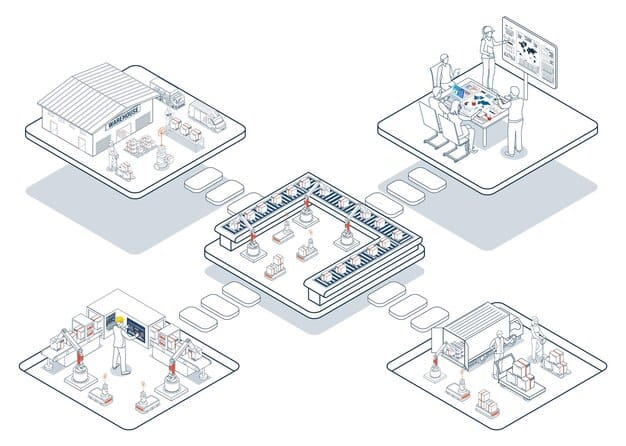
| Key Feature | Brief Description |
|---|---|
| 🤖 Modularity | Allows rapid swapping of payloads for diverse missions (recon, combat, logistics). |
| 🧠 Advanced Autonomy | Enables independent operation, path planning, and human-machine teaming. |
| 👁️🗨️ Enhanced SA | Sophisticated sensors provide real-time, comprehensive battlefield intelligence. |
| 💥 Lethality & Survivability | Increased firepower & reduced risk to personnel due to unmanned nature. |
Frequently asked questions about Robotic Combat Vehicles
The primary role of RCVs is to augment manned combat systems by performing dangerous or repetitive tasks. They enhance situational awareness, provide additional firepower, conduct reconnaissance, and reduce direct risk to human soldiers by operating in high-threat environments. They are designed to be force multipliers, extending the reach and effectiveness of existing units without increasing human exposure.
Currently, the US Army’s RCVs operate with varying degrees of autonomy. For lethal actions, a human remains “in the loop,” providing final authorization before engaging targets. However, RCVs are being developed with advanced autonomous capabilities for navigation, obstacle avoidance, and target identification, reducing the burden on human operators for non-lethal tasks and reconnaissance.
Modularity is a core design principle, allowing RCVs to quickly adapt to diverse mission requirements. Various payloads, such as different weapon systems, sensor packages, or logistical modules, can be easily swapped. This flexibility reduces the need for specialized vehicles, lowers development costs, and ensures RCVs remain relevant as battlefield needs evolve, optimizing their multi-role capabilities.
Significant challenges include ensuring robust communication links in contested environments, developing more sophisticated AI for complex decision-making, and securing the systems against cyber threats. Institutional challenges involve adapting military doctrine, training protocols, and fostering human-machine trust. Ethical considerations regarding autonomous systems and public perception also require careful management and transparent communication.
RCVs enhance soldier survivability by allowing military personnel to engage in combat or reconnaissance from a safer distance. They can scout ahead into dangerous areas, draw enemy fire, identify threats, and retrieve critical intelligence without exposing human lives to direct harm. This tactical advantage ensures that soldiers are deployed in environments with significantly reduced risk, preserving combat strength.
Conclusion
The US Army’s commitment to developing and integrating Robotic Combat Vehicles marks a pivotal moment in military innovation. These unmanned platforms, characterized by their modularity, advanced autonomy, sophisticated sensor suites, and inherent survivability, are poised to reshape the dynamics of modern warfare. They promise to enhance lethality while crucially reducing the risks to human personnel, offering a tactical advantage that is both technologically advanced and ethically responsible. While significant challenges in integration, cybersecurity, and human-machine trust remain, the ongoing iterative development and the strategic imperative to maintain overmatch suggest a future where RCVs are an indispensable component of the Army’s fighting force. Their continued evolution will not only redefine battlefield operations but also set new standards for military capability in the 21st century.
